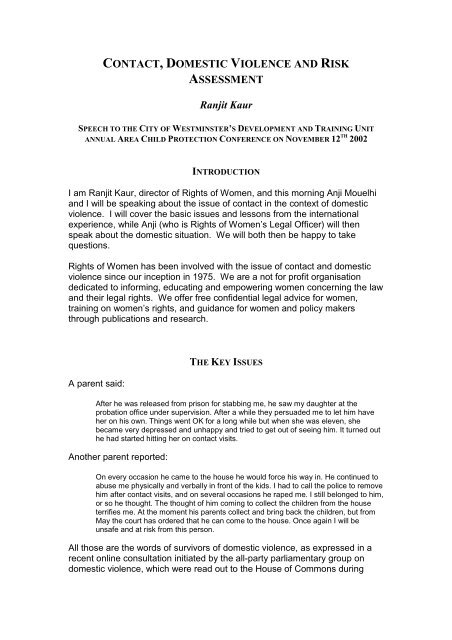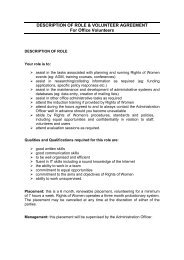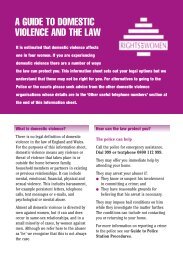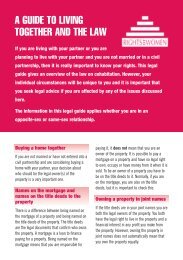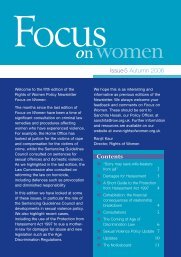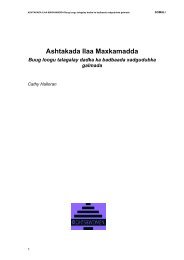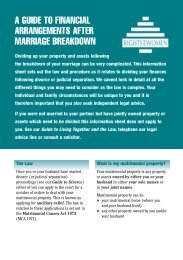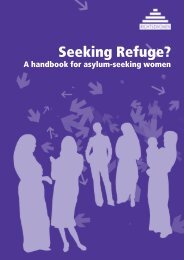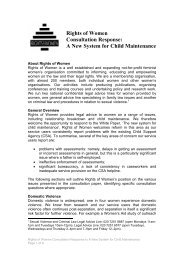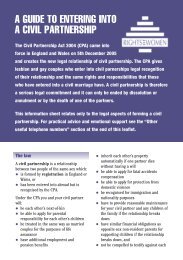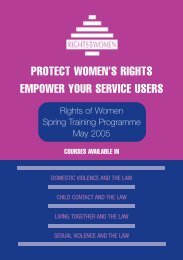contact, domestic violence and risk assessment - Rights of Women
contact, domestic violence and risk assessment - Rights of Women
contact, domestic violence and risk assessment - Rights of Women
Create successful ePaper yourself
Turn your PDF publications into a flip-book with our unique Google optimized e-Paper software.
CONTACT, DOMESTIC VIOLENCE AND RISK<br />
ASSESSMENT<br />
Ranjit Kaur<br />
SPEECH TO THE CITY OF WESTMINSTER’S DEVELOPMENT AND TRAINING UNIT<br />
ANNUAL AREA CHILD PROTECTION CONFERENCE ON NOVEMBER 12 TH 2002<br />
INTRODUCTION<br />
I am Ranjit Kaur, director <strong>of</strong> <strong>Rights</strong> <strong>of</strong> <strong>Women</strong>, <strong>and</strong> this morning Anji Mouelhi<br />
<strong>and</strong> I will be speaking about the issue <strong>of</strong> <strong>contact</strong> in the context <strong>of</strong> <strong>domestic</strong><br />
<strong>violence</strong>. I will cover the basic issues <strong>and</strong> lessons from the international<br />
experience, while Anji (who is <strong>Rights</strong> <strong>of</strong> <strong>Women</strong>’s Legal Officer) will then<br />
speak about the <strong>domestic</strong> situation. We will both then be happy to take<br />
questions.<br />
<strong>Rights</strong> <strong>of</strong> <strong>Women</strong> has been involved with the issue <strong>of</strong> <strong>contact</strong> <strong>and</strong> <strong>domestic</strong><br />
<strong>violence</strong> since our inception in 1975. We are a not for pr<strong>of</strong>it organisation<br />
dedicated to informing, educating <strong>and</strong> empowering women concerning the law<br />
<strong>and</strong> their legal rights. We <strong>of</strong>fer free confidential legal advice for women,<br />
training on women’s rights, <strong>and</strong> guidance for women <strong>and</strong> policy makers<br />
through publications <strong>and</strong> research.<br />
A parent said:<br />
THE KEY ISSUES<br />
After he was released from prison for stabbing me, he saw my daughter at the<br />
probation <strong>of</strong>fice under supervision. After a while they persuaded me to let him have<br />
her on his own. Things went OK for a long while but when she was eleven, she<br />
became very depressed <strong>and</strong> unhappy <strong>and</strong> tried to get out <strong>of</strong> seeing him. It turned out<br />
he had started hitting her on <strong>contact</strong> visits.<br />
Another parent reported:<br />
On every occasion he came to the house he would force his way in. He continued to<br />
abuse me physically <strong>and</strong> verbally in front <strong>of</strong> the kids. I had to call the police to remove<br />
him after <strong>contact</strong> visits, <strong>and</strong> on several occasions he raped me. I still belonged to him,<br />
or so he thought. The thought <strong>of</strong> him coming to collect the children from the house<br />
terrifies me. At the moment his parents collect <strong>and</strong> bring back the children, but from<br />
May the court has ordered that he can come to the house. Once again I will be<br />
unsafe <strong>and</strong> at <strong>risk</strong> from this person.<br />
All those are the words <strong>of</strong> survivors <strong>of</strong> <strong>domestic</strong> <strong>violence</strong>, as expressed in a<br />
recent online consultation initiated by the all-party parliamentary group on<br />
<strong>domestic</strong> <strong>violence</strong>, which were read out to the House <strong>of</strong> Commons during
debates on child <strong>contact</strong> 1 . The courts frequently award <strong>contact</strong> to fathers who<br />
have been violent within the family.<br />
Two women every week are killed in the UK by partners or ex-partners 2 . The<br />
Solicitor-General, Harriet Harman, announced in October that provisions<br />
against <strong>domestic</strong> <strong>violence</strong> would appear in the forthcoming Criminal Justice<br />
Bill. These provisions would be enable the authorities to prosecute men who<br />
repeatedly commit <strong>domestic</strong> <strong>violence</strong>, regardless <strong>of</strong> whether the woman<br />
decides to press charges. That the government is taking this issue seriously<br />
is to be commended, although we are concerned that women may be forced<br />
to give evidence against their will. However, the failings in the current regime<br />
<strong>of</strong> <strong>contact</strong> need to be addressed urgently as part <strong>of</strong> any joined up strategy on<br />
<strong>domestic</strong> <strong>violence</strong>, as the system as it st<strong>and</strong>s fails to protect either women or<br />
their children from <strong>violence</strong>.<br />
Since the implementation <strong>of</strong> the Children Act 1989 in October 1991, concerns<br />
have been expressed by women’s groups, legal practitioners, advice workers,<br />
academics <strong>and</strong> refuges about the practice <strong>of</strong> <strong>contact</strong>. Where <strong>contact</strong> was<br />
ordered between a child <strong>and</strong> a violent father, evidence emerged <strong>of</strong> <strong>risk</strong>s that:<br />
• <strong>Women</strong> would suffer continued <strong>violence</strong> <strong>and</strong> abuse<br />
• Children would directly witness or hear <strong>violence</strong> <strong>and</strong> abuse<br />
• Children would be affected directly by trying to intervene in violent <strong>and</strong><br />
abusive behaviour by fathers towards mothers or by being manipulated by<br />
fathers into facilitating this behaviour<br />
• Children would be affected indirectly by the psychological <strong>and</strong> practical<br />
effects <strong>of</strong> continued <strong>violence</strong> towards <strong>and</strong> abuse <strong>of</strong> their mothers 3 .<br />
Presumption <strong>of</strong> Contact<br />
Courts in the UK make a presumption <strong>of</strong> <strong>contact</strong> with the father 4 . Domestic<br />
<strong>violence</strong> does not constitute a bar to <strong>contact</strong>, <strong>and</strong> the courts frequently award<br />
<strong>contact</strong> to fathers who have been violent. If a mother refuses to obey a<br />
<strong>contact</strong> order in order to protect herself <strong>and</strong> her children from a violent expartner,<br />
she may be labelled ‘implacably hostile’. This implies vindictive<br />
behaviour, <strong>and</strong> continued refusal may result in her being sent to prison.<br />
A major study <strong>of</strong> the <strong>contact</strong> regimes in Engl<strong>and</strong> <strong>and</strong> Denmark in 1996<br />
recommended that there should be a presumption <strong>of</strong> no <strong>contact</strong> where it is<br />
proven that there has been <strong>domestic</strong> <strong>violence</strong> 5 . This would entail reform<br />
along the New Zeal<strong>and</strong> model, which we will return to in more detail shortly.<br />
1 Hansard 7 Jun 2000 : Column 108WH<br />
2 Home Office statistics on homicide<br />
3 <strong>Rights</strong> <strong>of</strong> <strong>Women</strong>, Contact between Children <strong>and</strong> Violent Fathers: in whose Best Interests?<br />
1997<br />
4 Bailey-Harris, Barron, <strong>and</strong> Pearce, From Utility to <strong>Rights</strong>? The Presumption <strong>of</strong> Contact in<br />
Practice, International Journal <strong>of</strong> Law, Policy <strong>and</strong> the Family 13, (1999) 111-131; also Smart<br />
<strong>and</strong> Neale, Arguments Against Virtue: Must Contact be Enforced? May [1997] Fam Law 332<br />
5 Hester <strong>and</strong> Radford, Domestic Violence <strong>and</strong> Child Contact Arrangements in Engl<strong>and</strong> <strong>and</strong><br />
Denmark, Policy Press 1996
The Advisory Board on Family Law Children Act Sub-Committee in its major<br />
2002 report to the Lord Chancellor’s Department advises against adopting<br />
such a model but recommended that there should be Good Practice<br />
Guidelines to be used at every level <strong>of</strong> the court, with the question <strong>of</strong><br />
legislation to be revisited after evaluation <strong>of</strong> the impact <strong>of</strong> guidelines 6 . We<br />
would strongly endorse the need for new legislation on the New Zeal<strong>and</strong><br />
model, the need for which is illustrated by the unacceptable <strong>risk</strong>s posed to<br />
women <strong>and</strong> their children by the current system.<br />
Risk to women<br />
One in four women experiences <strong>domestic</strong> <strong>violence</strong>, which <strong>of</strong>ten continues<br />
after the relationship is over 7 . A study undertaken in 1996 <strong>of</strong> 79 mothers who<br />
had been abused by partners in Engl<strong>and</strong> <strong>and</strong> Denmark found that 74 <strong>of</strong> the<br />
women had been assaulted by ex-partners when participating in <strong>contact</strong> visits,<br />
<strong>and</strong> that half <strong>of</strong> the 53 women from Engl<strong>and</strong> said that their children had<br />
suffered physical or sexual abuse from the ex-partners, but <strong>contact</strong> continued<br />
in all cases bar six, with poor provisions made to ensure the children’s safety.<br />
Risk to Children<br />
A great deal <strong>of</strong> research identifies a link between <strong>violence</strong> to a mother <strong>and</strong><br />
child abuse 8 . Contact can be used as a means to continue abuse, or to<br />
exercise control over the mother. Social services on Merseyside indicate that<br />
<strong>domestic</strong> <strong>violence</strong> is a feature in approximately 40-50% <strong>of</strong> cases that are<br />
brought to the attention <strong>of</strong> child protection case conferences 9 . Child abuse<br />
<strong>and</strong> woman abuse occur together in 40-60% <strong>of</strong> cases 10 . In 30-40% <strong>of</strong> families<br />
where the man is being violent to his partner, the children are also being<br />
physically or sexually abused 11 .<br />
In their survey <strong>of</strong> <strong>contact</strong> proceedings, Judges have a ‘tendency to treat past<br />
conduct as irrelevant to the determination <strong>of</strong> a <strong>contact</strong> application, <strong>and</strong> this<br />
includes <strong>violence</strong> directed by the father towards the mother’ (Bailey-Harris et<br />
al, p. 123) 12 . The same study found that where a father had been violent,<br />
supervised <strong>contact</strong> was usually recommended, with the possibility <strong>of</strong><br />
increased <strong>contact</strong> if this was felt to have gone well. The 1995 overview <strong>of</strong><br />
research studies on child protection commissioned by the Department <strong>of</strong><br />
Health identified <strong>domestic</strong> <strong>violence</strong> as an issue in many families who were<br />
likely to maltreat their children 13 . The same report highlighted that ‘<strong>domestic</strong><br />
6 Advisory Board on Family Law Children Act Sub-Committee, Report to the Lord Chancellor<br />
on the Question <strong>of</strong> Parental Contact in Cases where there is Domestic Violence, HMSO, 2002<br />
7 Greater London Assembly, London Domestic Violence Strategy, November 2001<br />
8 see for example Hester <strong>and</strong> Radford, Domestic Violence <strong>and</strong> Child Contact Arrangements in<br />
Engl<strong>and</strong> <strong>and</strong> Denmark, Policy Press 1996<br />
9 Sefton Social Services Dept – year end 31 March 1999.<br />
10 Hughes et al, 1989.<br />
11 Strauss, Gelles <strong>and</strong> Steinmetz, 1980.<br />
12 Bailey-Harris, Barron, <strong>and</strong> Pearce, From Utility to <strong>Rights</strong>? The Presumption <strong>of</strong> Contact in<br />
Practice, International Journal <strong>of</strong> Law, Policy <strong>and</strong> the Family 13, (1999) 111-131<br />
13 Department <strong>of</strong> Health, The Children Act Now: Messages from Research, p. 29
<strong>violence</strong> was present in nearly half <strong>of</strong> the cases in the safeguarding children<br />
study but was rarely mentioned in child protection plans’ 14 .<br />
A major analysis <strong>of</strong> research projects found that 40-60% <strong>of</strong> cases <strong>of</strong> <strong>domestic</strong><br />
<strong>violence</strong> against the mother, the same male perpetrator abused the children<br />
(Hughes et al 1989 cited in <strong>Women</strong>’s Aid p. 3) 15 . The report <strong>of</strong> Drs Sturge<br />
<strong>and</strong> Glaser commissioned for use in an important Court <strong>of</strong> Appeal case on<br />
this issue highlighted the dangerous effects <strong>of</strong> witnessing <strong>domestic</strong> <strong>violence</strong> 16 .<br />
Their comprehensive research showed that children still suffered emotional<br />
trauma even when they were not directly involved in the <strong>violence</strong>. Their<br />
recommendation was ‘not only that there should be no automatic assumption<br />
that <strong>contact</strong> to a previously or currently violent parent was in the child’s<br />
interests, if anything the assumption should be in the opposite direction <strong>and</strong><br />
he should prove why he can <strong>of</strong>fer something <strong>of</strong> benefit to the child <strong>and</strong> the<br />
child’s situation’ 17 . They found that:<br />
Domestic <strong>violence</strong> involves a very serious <strong>and</strong> significant failure in<br />
parenting – failure to protect the child’s carer <strong>and</strong> failure to protect the<br />
child emotionally (<strong>and</strong> in some cases physically – which meets any<br />
definition <strong>of</strong> child abuse) 18 .<br />
The Children Act Sub Committee <strong>of</strong> the Advisory Board on Family Law called<br />
for the Lord Chancellor’s Department to commission major long term research<br />
into the effects on children <strong>of</strong> witnessing <strong>domestic</strong> <strong>violence</strong> 19 (p. 9). Further,<br />
we strongly dispute the assertion <strong>of</strong> groups such as Families Need Fathers<br />
that there should be a presumption <strong>of</strong> <strong>contact</strong> regardless <strong>and</strong> that ‘residence<br />
<strong>and</strong> <strong>contact</strong> orders should be used in exceptional circumstances only eg.<br />
when proven <strong>risk</strong> to child – residence [should be with] one parent, supervised<br />
<strong>contact</strong> to the other’ 20 .<br />
Our recommendations<br />
<strong>Rights</strong> <strong>of</strong> <strong>Women</strong> believes that the catastrophic failures in the <strong>contact</strong> system<br />
must be addressed. We believe that the government should act immediately<br />
to ensure the safety <strong>of</strong> women <strong>and</strong> children at <strong>risk</strong> <strong>of</strong> further <strong>violence</strong>. We<br />
want:<br />
• The Children Act should be amended to give a rebuttable presumption <strong>of</strong><br />
no <strong>contact</strong> where there has been <strong>domestic</strong> <strong>violence</strong><br />
• Further amendments to family legislation including<br />
14 Department <strong>of</strong> Health, The Children Act Now: Messages from Research, ??year, p. 45<br />
15 Need to get full ref – not listed on doc<br />
16 Sturge <strong>and</strong> Glaser, Contact <strong>and</strong> Domestic Violence – the Experts’ Court Report, [2000]<br />
Fam Law 615<br />
17 Cited in Re L; Re V; Re M; Re H [2000] 2 FLR 339<br />
18 see note 11, p. 623<br />
19 Advisory Board on Family Law Children Act Sub-Committee, A report to the Lord<br />
Chancellor on the Question <strong>of</strong> Parental Contact in Cases where there is Domestic Violence,<br />
2000<br />
20 Families Need Fathers, Response to Making Contact Work, section 1
- changes to the Children Act to consider the value <strong>and</strong> quality <strong>of</strong><br />
<strong>contact</strong> for children;<br />
- changes to the Children Act welfare checklist <strong>and</strong> s. 31 to<br />
include in the definition <strong>of</strong> psychological harm <strong>violence</strong> to a<br />
family member with the effects on children <strong>of</strong> such <strong>violence</strong> to<br />
be considered;<br />
- a procedural amendment to provide for dismissal <strong>of</strong> Children Act<br />
cases at the outset when made by seriously violent or abusive<br />
applicants.<br />
• Department <strong>of</strong> Health to urgently analyse review <strong>of</strong> child homicide cases<br />
involving <strong>domestic</strong> <strong>violence</strong> in order to draw up more effective <strong>risk</strong><br />
<strong>assessment</strong> procedures.<br />
• Protocol to be introduced to prevent abusers using Seek <strong>and</strong> Find Orders<br />
to locate their ex-partner<br />
• Compulsory, nation-wide training for Court Welfare Officers, mediators,<br />
solicitors, barristers <strong>and</strong> judges on children <strong>and</strong> <strong>domestic</strong> <strong>violence</strong><br />
• Increased access to Legal Aid for <strong>domestic</strong> <strong>violence</strong> cases [check current<br />
status with Anji]<br />
To make the government’s new stance on <strong>domestic</strong> <strong>violence</strong> not only tenable<br />
but safe, changes must be made to the <strong>contact</strong> system. To encourage<br />
women to break the silence <strong>and</strong> then enforce potentially lethal <strong>contact</strong><br />
meetings is irresponsible in the extreme.<br />
Introduction<br />
LESSONS FROM THE INTERNATIONAL EXPERIENCE<br />
The UK may be able to benefit from the experience <strong>of</strong> other countries in<br />
dealing with the issue <strong>of</strong> child <strong>contact</strong> <strong>and</strong> <strong>domestic</strong> <strong>violence</strong>. Improved<br />
protection against <strong>domestic</strong> <strong>violence</strong> impacts directly on child <strong>contact</strong><br />
issues 21 . What follows is not a comprehensive survey <strong>of</strong> international practice<br />
(this would take several books!) but a brief mention <strong>of</strong> some <strong>of</strong> the more<br />
innovative approaches the UK might learn from.<br />
Austria<br />
Austrian police may now remove an <strong>of</strong>fender from home for 10 days if they<br />
believe <strong>domestic</strong> <strong>violence</strong> has taken place <strong>and</strong> is likely to recur. A court can<br />
then extend this order at the woman’s request, <strong>and</strong> both parties can<br />
separately attend support projects after the action. This law allows the police<br />
to act immediately to protect women.<br />
Other European states<br />
21 Kelly, Specific Domestic Violence Legislation: Examples <strong>and</strong> Advantages, January 2001,<br />
www.<strong>domestic</strong><strong>violence</strong>data.org/3_notice/forum/liz_legn.htm
Other European legislation specifies that criminal assault on an intimate<br />
partner should affect sentencing – Belgium, Spain <strong>and</strong> France all enacted<br />
such legislation in the 1990s. Sweden has a new law recognising the ongoing<br />
nature <strong>of</strong> <strong>domestic</strong> <strong>violence</strong>, which criminalises the ‘gross violation <strong>of</strong> a<br />
woman’s integrity’, which may be made alongside charges for assaults 22 . In<br />
Northern Irel<strong>and</strong>, where someone who is subject to a non-molestation order<br />
applies for <strong>contact</strong>, the court must consider whether the child has or is at <strong>risk</strong><br />
<strong>of</strong> suffering harm through witnessing <strong>domestic</strong> <strong>violence</strong>.<br />
The Americas<br />
In some Latin American states <strong>and</strong> US states specific criminal <strong>of</strong>fences <strong>of</strong><br />
<strong>domestic</strong> <strong>violence</strong> have been created. The US Violence Against <strong>Women</strong> Act<br />
includes within the statute specified resources. The US also has a Model<br />
code with a rebuttable presumption that it will be in the child’s best interests to<br />
live with the non-abusing parent, <strong>and</strong> <strong>contact</strong> may only be awarded where the<br />
safety <strong>of</strong> the child <strong>and</strong> non-abusing parent can be guaranteed 23 .<br />
New Zeal<strong>and</strong><br />
The New Zeal<strong>and</strong> system is considered to be particularly strong with respect<br />
to child <strong>contact</strong> as it features a rebuttable presumption that there should not<br />
be <strong>contact</strong> unless the court can be sure that the mother <strong>and</strong> child will be safe.<br />
The law has a <strong>risk</strong> <strong>assessment</strong> checklist that must be considered by the court<br />
before <strong>contact</strong> is awarded. All children are represented in family proceedings.<br />
There is no power to imprison a mother who refuses to comply with a <strong>contact</strong><br />
order or similar agreement. Children have a right to oppose access – the<br />
older <strong>and</strong> more mature a child is the more weight will be given to her wishes.<br />
Most respondents favouring legislative change in the UK on this issue as<br />
canvassed by the Advisory Board on Family Law Children Act Sub-Committee<br />
favoured reform on the New Zeal<strong>and</strong> model. New Zeal<strong>and</strong>’s Guardianship<br />
Act features a m<strong>and</strong>atory <strong>risk</strong> <strong>assessment</strong> checklist, <strong>and</strong> Dr Radford finds that<br />
a similar provision in the UK ‘would enable the courts to systematically assess<br />
the impact <strong>of</strong> the <strong>domestic</strong> <strong>violence</strong> upon the child <strong>and</strong> the <strong>risk</strong>s <strong>of</strong> <strong>contact</strong> in<br />
cases where there may not be a previous court order or injunction’ 24 . The<br />
Domestic Violence Act <strong>of</strong> 1995 provides that when there is a Protection Order<br />
in place, the respondent may not <strong>contact</strong> any child <strong>of</strong> the applicant’s family,<br />
unless <strong>contact</strong> is permitted under any order or written agreement. A major<br />
research project into the efficacy <strong>of</strong> the combined effects <strong>of</strong> the new Act <strong>and</strong><br />
the Guardianship Act found that:<br />
22 ibid.<br />
23 Cited in <strong>Women</strong>’s Aid briefing, September 2001,<br />
www.womensaid.org.uk/policy/briefings/child%20<strong>contact</strong>%20dv.htm<br />
24 Report per note 15, p. 25
Australia<br />
The provisions for access to children in the <strong>domestic</strong> <strong>violence</strong><br />
legislation have led to a growing use <strong>of</strong> access arrangements which<br />
are safer for both children <strong>and</strong> custodial parents 25 .<br />
The Australian equivalent <strong>of</strong> our welfare checklist instructs the court to<br />
consider the need to protect the child from physical or psychological harm<br />
caused, or that may be caused, by any family <strong>violence</strong> involving a child or a<br />
member <strong>of</strong> her family 26 . We believe that similar provisions should be added to<br />
our welfare checklist to increase the protection from abuse available to<br />
children, <strong>and</strong> by extension, their mothers.<br />
Human <strong>Rights</strong><br />
The UK’s obligations under international law are relevant where women suffer<br />
<strong>domestic</strong> <strong>violence</strong>. Such obligations may be found in the International<br />
Convention on Civil <strong>and</strong> Political <strong>Rights</strong>, Articles 2 <strong>and</strong> 26, <strong>and</strong> the<br />
Convention on the Elimination <strong>of</strong> All Forms <strong>of</strong> Discrimination Against<br />
<strong>Women</strong> 27 . In the European Convention on Human <strong>Rights</strong>, Articles 3 <strong>and</strong> 8<br />
place the state under a positive obligation to protect women from <strong>domestic</strong><br />
<strong>violence</strong>. These articles provide a prohibition on inhuman <strong>and</strong> degrading<br />
treatment <strong>and</strong> also protect physical integrity <strong>and</strong> family life 28 . This is therefore<br />
arguable under the Human <strong>Rights</strong> Act 1998. When the state fails to protect<br />
women from <strong>domestic</strong> <strong>violence</strong> it fails in its international human rights<br />
obligations. A <strong>contact</strong> regime which systematically exposes women, <strong>and</strong><br />
children, to <strong>domestic</strong> <strong>violence</strong> cannot be fully compliant with such norms.<br />
CONCLUSION<br />
In conclusion, I would like to reiterate that if we are to see an effective, human<br />
rights compliant state response to <strong>domestic</strong> <strong>violence</strong>, we must see urgent <strong>and</strong><br />
substantial reforms made to the <strong>contact</strong> system as it st<strong>and</strong>s.<br />
25 Ministry <strong>of</strong> Justice (New Zeal<strong>and</strong>), The Domestic Violence Legislation <strong>and</strong> Child Access in<br />
New Zeal<strong>and</strong>, 1999<br />
26 Family Law Act 1975 (Australia) ss. 68F <strong>and</strong> 68K<br />
27 for details see Finlay, Bailey-Harris, Otlowski, Family Law in Australia, Fifth Edition, 1997,<br />
p. 542<br />
28 Starmer, European Human <strong>Rights</strong> Law, LAG, 1997, ss. 19.50-19.52


